Member Spotlight
Powell Wellness Center (PWC) is proud to highlight our members’ wellness stories!
Will you be next?! To tell your story or nominate someone else, please get in touch with PWC medical program leader Whitney Propps (540-445-5388 or email wpropps@culpeperwellness.org)
Share your story and inspire others!
Member Spotlight: Meet Kim
Kim has been working with personal trainer Bobby Zajkowski, first in the FitScripts program and then as a training client, with the goal of improving her overall fitness. She’s had much success: during the 8-week FitScripts program she lost 8.5 pounds and subsequently lost just over 5 pounds more. Other markers of the progress Kim has made: her overall body fat percentage has dropped, her waist measurement is down and her flexibility has improved. Kim’s story is a great example of the success achieved by recognizing what works for you in terms of methods and tools, setting goals, and sticking with your efforts! We’re grateful to Kim for sharing her story.
Kim decided to join PWC and focus on her fitness after she went to the doctor for her physical. She says, “We got to talking about weight and all the fad diets or weight loss medicines being promoted now, and my doctor offered to prescribe a weight loss medicine for me. Hearing that I was the perfect candidate was a bit of a wake up call. After doing some research I decided that the best, most healthy way to accomplish my goal of weight loss and toning was through diet and exercise.”
As part of her membership, Kim took advantage of the wellness assessment, which helps establish a member’s starting point and show progress yearly. She wanted to learn more about how to use some of the machines. During the assessment she heard about the FitScripts program and felt it was something she could benefit from. FitScripts is an eight-week program of supervised sessions in a small group setting, and diet & weight loss is one of the “tracks” supported by the program.
Kim observes, “I had never worked with a trainer or done a program like FitScripts. I consider myself a very active person as I hardly ever sit down. I have worked out on and off over the years. Prior to Covid, I swam laps regularly. Most everything I have done has been single activity focused, such as swimming laps, using the elliptical, walking or aerobics classes. Bobby has taught me a variety of workouts so that every day is different.”
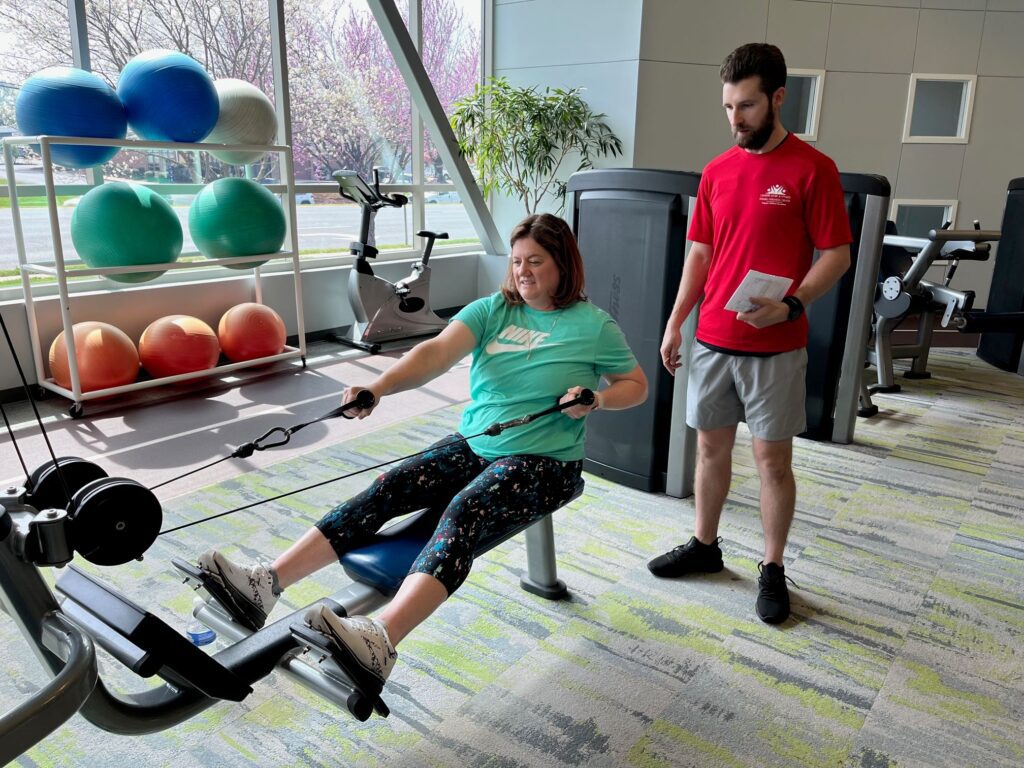
Kim says she set short and long term goals, and finds herself setting new smaller goals to challenge herself while working out. “Bobby encouraged me to wear my Apple watch and track my steps and calories burned each day. He showed me how to set up a fitness group and now my whole family and a few friends are all in a group. We compete against each other and keep each other motivated. I have my goal for calories burned every day set at 800 and I try my best to move enough to meet that goal. When I first started wearing my watch, I was only getting to 400-500 calories burned. I thought hitting 800 would never happen, and now I usually hit that goal every day.”
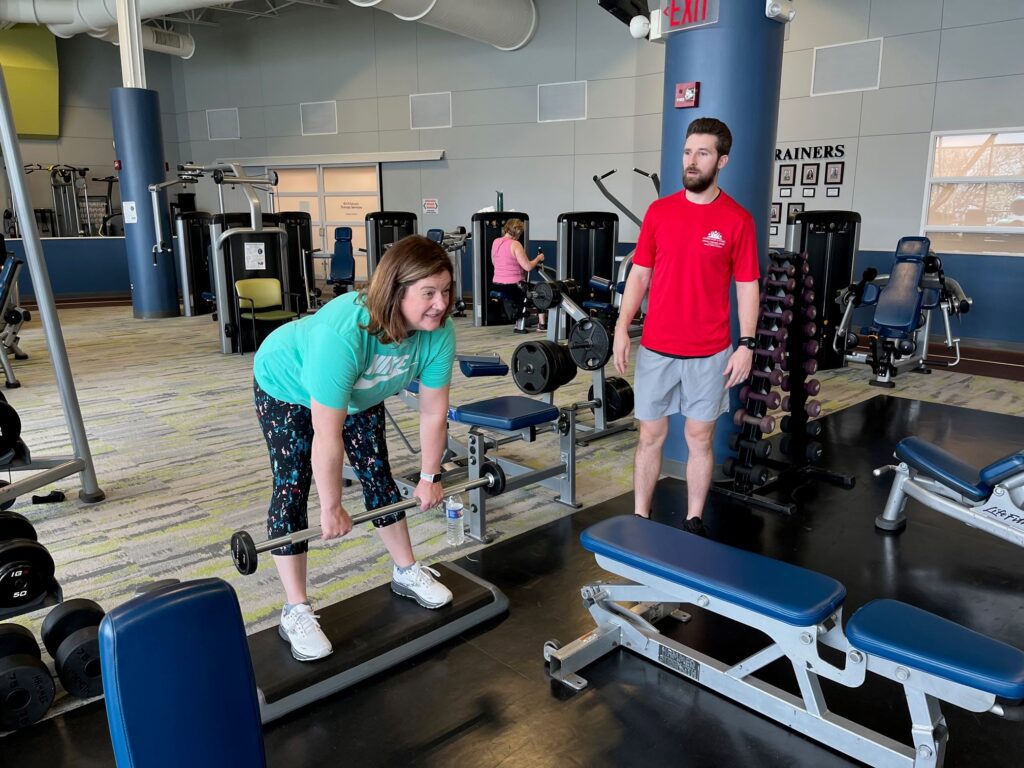
After 8 weeks of FitScripts and continuing to work with Bobby, Kim reflects, “I have soooooo much more energy! I was having a lot of lower back pain when I started and that has gotten so much better. I’ve gone down one size in clothing and feel more comfortable wearing cute outfits now! I have learned so much more about working out and I keep learning new stuff every day. I made a new friend in Bobby and even got to know his mom; I look forward to going to the Pound class with her!”
Overall, Kim says she feels so much better about her health than she did when she first started working out. “I physically feel better, my resting heart rate has gone down and so has my blood pressure. I actually can’t wait to see my doctor again because I feel like she is going to be so excited to see my progress!”
Member spotlight: Meet Rick
An individual’s overall health and commitment to rehabilitation, plus use of support resources, time and other factors, all play a role in guiding a return to an active lifestyle after suffering a debilitating health challenge. In this spotlight, PWC members Rick and Karen share Rick’s rehabilitation experience after he suffered a stroke in March 2020.
As a first step in his recovery, Rick pursued extensive physical therapy with Culpeper Medical Center Physical Therapy and Rehabilitation Services, located at PWC. In fall 2020 Rick and Karen felt ready to stay active on their own and they decided to become PWC members.
Initially, Rick exercised on the NuStep recumbent cross trainer, but Karen remembers that he always had his eye on the pool. She recalls, “The thought was overwhelming that he could ever get into the pool. I was worried about needing to get Rick into the water with a chair lift and using a wheelchair around the pool… you name it, I worried and so did Rick.”
During one of their visits to PWC, Rick and Karen happened to see personal trainer Heather Boggess working with a client. “We could tell that she was good at working with someone who was suffering from a debilitating problem,” says Karen. The couple followed up and contacted Heather.
Heather says, “Once we sat down to discuss some of Rick’s goals, I suggested the pool as a place to start. He wanted to strengthen his right side more as that was the side affected by the stroke. I explained the benefits of water training and Rick and Karen were immediately on board. The water gives people more confidence and it’s a safe place to regain more function due to being surrounded by resistance.”
The main training goal for Rick was to build confidence in using the right side of his body. Karen observes, “His leg improvement has been amazing and we are hoping to work more on his right hand. Rick would still like to be able to use his right hand to eat and write but this is a big challenge since some of the challenges (rotator cuff problems) are unrelated to the stroke.”
In their sessions, Rick and Heather constantly practice making the connection that his brain still communicates to his right side. Heather says, “We complete various drills; for instance, one where Rick aims to bring his knee to a certain area and balance without losing control on his right side. After more than 14 sessions together, he is able to walk in the water independently, and has progressed to walking more independently on land as we exit the pool.”
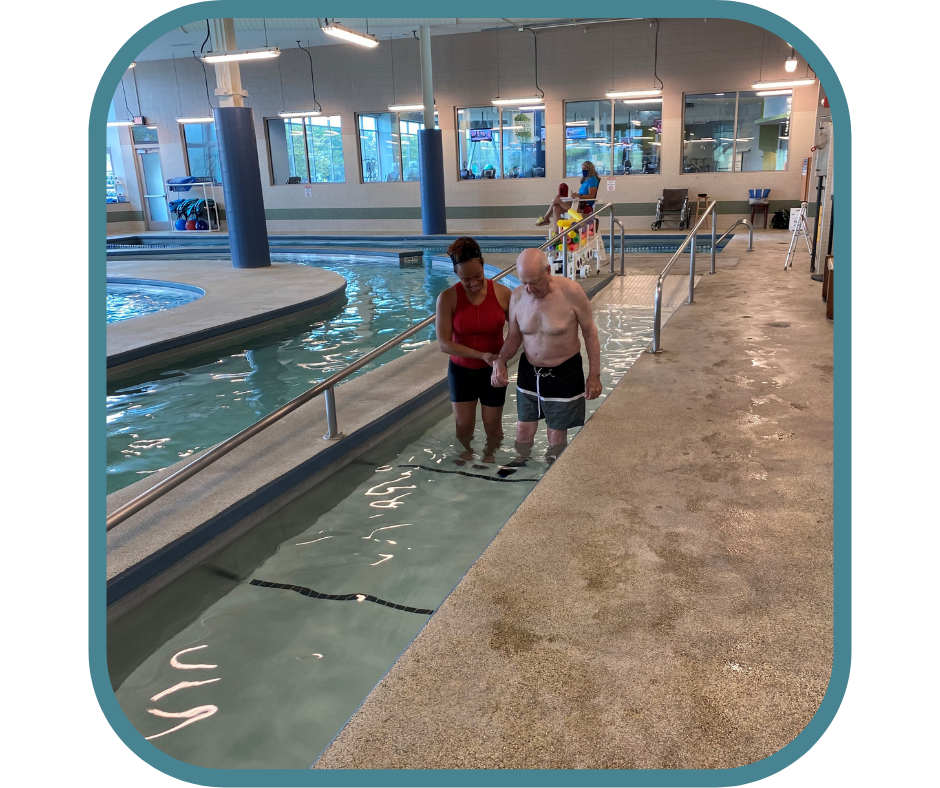
“We can’t believe all the positives that have come out of the work with Heather,” says Karen. She and Rick highlight the following:
- A big mental boost – recognition that it is possible to have some fun in life again
- Balance developed for walking unassisted in the water
- Using steps to get into and out of water has become a regular practice
- Range of motion activity with both arms has become easier
- Training right hand to grasp pool bar has become natural
- Walking forward and backward in water achieved
- Walking the ramp into the pool
- Understanding commands for left leg versus right leg
- Improvements in speech as a result of talking things through slowly
Reflecting on the role of personal training in Rick’s recovery, Karen notes that it is hard to put into words. “There was a subtle build up in learning to trust Heather,” she says, adding, “You can’t go forward if you’re not bonding with your trainer. Heather’s dad had a hemorrhagic stroke and this went a long way towards helping Rick trust her and know that she wouldn’t see him as hopeless. She also shares a certain sense of humor with Rick – they are on the same channel, so to speak.”
Another important component of Rick’s recovery effort was the coordination between his personal training experience with Heather and the physical therapists who had worked with him earlier. Karen says, “There was good interaction with Daniel McEwen and Stacy Keser, the physical therapists of Culpeper Medical Center’s rehabilitation center at PWC. They were instrumental in getting information to Heather for his shoulder exercises in the water.”
The integration of physical therapy and personal training for recovery is important. Heather explains, “Physical therapy is to get you functioning again, and personal training will build upon that foundation to make it firmer, and then progress to strengthening. The two work hand in hand.”
Hand in hand also describes the partnership between Karen and Rick in support of his recovery. Heather says, “Rick wants to improve and Karen supports him and continues the exercises at home that were received in PT. Once Karen and Rick feel they’ve mastered one area, we add another step to move toward Rick’s next goal.”
Thank you to Rick and Karen for sharing Rick’s recovery journey.
Member spotlight: Meet Elizabeth
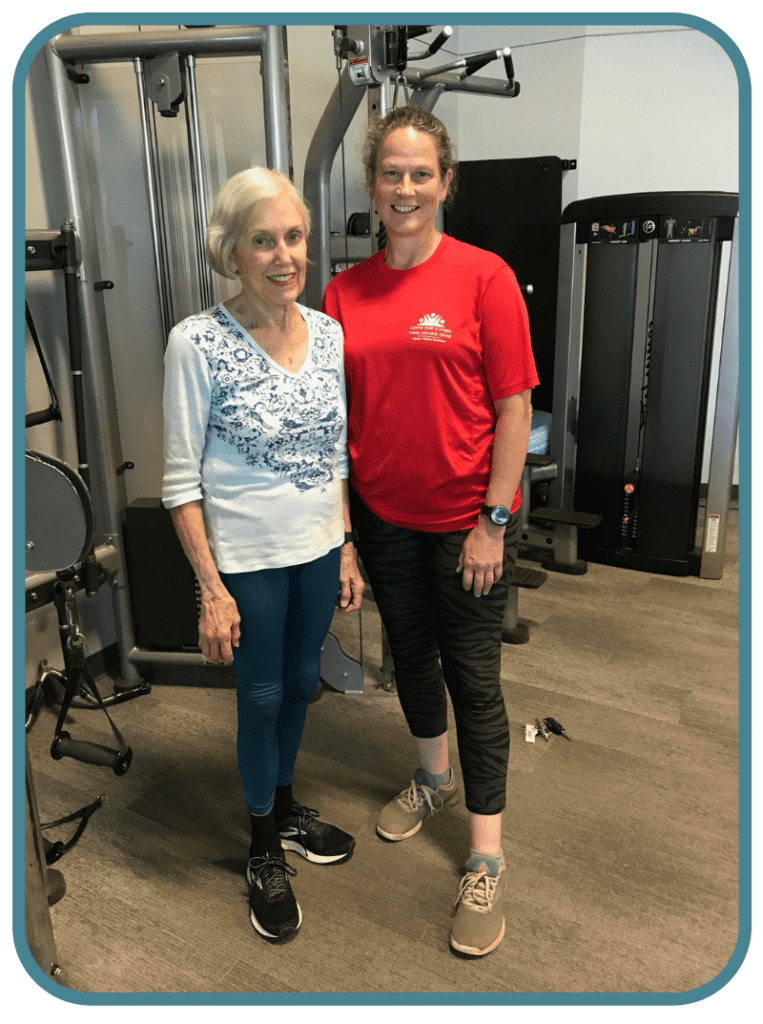
Elizabeth, pictured above with personal trainer Amy Biddle, describes herself as someone who likes to move, and she focuses her personal fitness with a commitment to maintaining her level of activity. When she joined PWC, Elizabeth approached the training staff to seek guidance with her workout. She was intent on following a program that was safe and that would best support her health needs, which include managing arthritis. She was linked with personal trainer Amy Biddle, and for the past two years the pair have been meeting twice a week to work on strength and mobility. In addition, Elizabeth generally walks about a mile on the track after her training session and enjoys walking near her home.
Elizabeth values her relationship with Amy and describes it as a “good match.” She observes that this scheduled and consistent approach helps her maintain general fitness. She also enjoys the Gentle Yoga class that Amy teaches on Thursday evenings. With her fitness plan in place, Elizabeth is maintaining mobility and flexibility, which help her face the challenges posed by arthritis.
Thanks to Elizabeth for sharing her story!
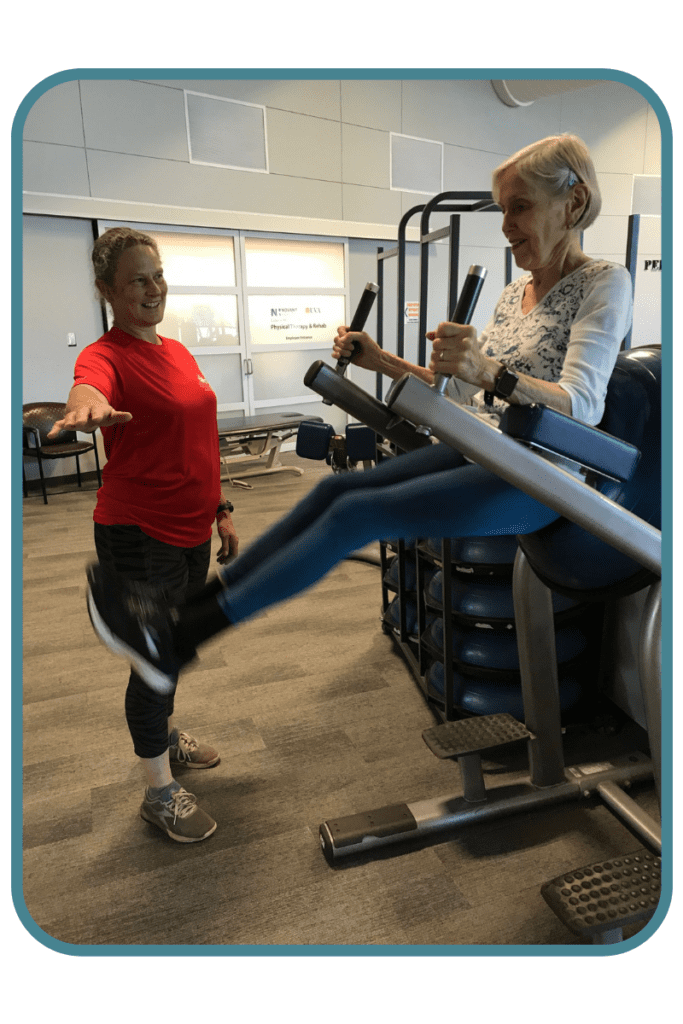
Member spotlight: Meet Mary
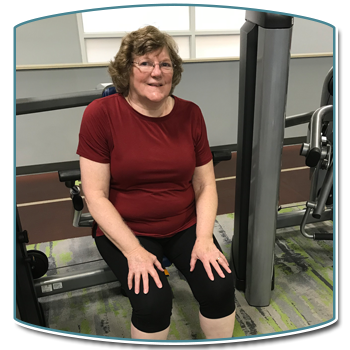
Mary at the LifeFitness triceps press, where she almost always begins her workout
Supported by her own tenacity and the assistance of physical therapy and the PWC FitScripts program, PWC member Mary is back to enjoying her active lifestyle enhanced by special time with her 4-year-old grandson.
In 2009, Mary had surgery for a left knee replacement. She experienced a challenging and pain-filled recovery that left her unable to fully extend her left leg. Compensating on her right side led to discomfort and alignment challenges in her right leg over the long term.
Mary joined PWC in 2012 and walked in the river to keep herself moving and to encourage joint mobility. But in 2013, Mary experienced an accident that injured her right knee. After suffering for a few years, she found a new doctor who encouraged her to pursue a knee replacement, a decision Mary was not keen on given her previous negative experience.
But nothing motivates like the words, “Grandma, get on the floor and play!” Mary had started caring for her young grandson one day a week when he was a baby, and as he grew it became hard to match his level of play and enjoy fun activities with him. So she made the decision to schedule another knee replacement in 2019.
“This time was different, from the beginning,” Mary recalls. She participated in Culpeper Medical Center’s Joint Camp, which she found to be really informative and beneficial in terms of preparing her for the surgery. She describes her recovery as “fantastic,” with a much shorter hospital stay than with her first surgery and virtually no post-surgery pain.
After surgery, Mary elected to do physical therapy with Culpeper Medical Center Physical Therapy and Rehab. During her PT appointments, she used the strength machines on the PWC fitness floor and now has good mobility and flexibility in her right leg. When her therapy was complete, the therapist mentioned PWC’s FitScripts program as an option. Mary jumped right in.
Her FitScripts experience with exercise specialist Bobby Zajkowski included 16 visits. “FitScripts was great,” commented Mary. “They worked around my schedule so that even if I had travel or an appointment planned, I was able to get in my FitScripts session. My physical therapy and FitScripts experiences took the intimidation factor out of the gym. I built confidence and learned how to use the machines. Each week I would have two FitScripts sessions and then I’d usually visit a third time on my own.”
After her FitScripts session ended, Mary rejoined PWC as a member. She now works out on the strength machines and is trying to build slowly on the weight she lifts. At home, she has an elliptical and recumbent bike, and the benefits of stairs and a long driveway.
“I’m just not willing to sit down yet,” says Mary. That’s for sure; she is up and down the stairs frequently to get to her home craft studio where she does decorative painting and sews. Mary has made over 500 masks since the pandemic started. Many have been giveaways to the hospital and its thrift store, and some have gone to friends and family. Recently, for her grandson’s fourth birthday, Mary sewed dinosaur print masks for the party goodie bags. Now, when he gets out his dinosaurs and other animal toys to play with, Mary is right there alongside him.
Member spotlight: Meet Scott

In October 2019, PWC member Scott completed a 5-week trek across northern Spain on the Camino de Santiago – The Way of Saint James – a path that pilgrims have followed for centuries. His interest in doing the trek began about 15 years ago, when he met a woman who had completed the walk. “Her face was aglow as she talked about the experience,” remembered Scott. It stayed in the back of his mind until a few years ago, when he retired from federal service and began thinking about the Camino again.
The reasons that people hike the Camino are as numerous as the trekkers, who number about 300,000 a year, with increasing participation by hikers from the United States. Many trekkers are following a spiritual calling; they are on the trail to reach Santiago de Compostela, where the bones of St. James the Apostle are reportedly buried in the cathedral. Others may be walking the Camino for the physical challenge, or to allow themselves dedicated time for contemplation. There are other trails that feed into the Camino, and trekkers may follow those combined with sections of the Camino or choose the full 500 miles across northern Spain.
Much of this long route is in the Pyrenees mountains. This creates strenuous conditions for walking, particularly on the first third and the last third of the trail. The middle section is challenging in a different way. It traverses a flat and arid plain called the “meseta,” where there’s not much to see and it’s easy to start questioning your commitment to the trek, according to Scott.
Before taking on the full trek, in 2017 Scott and his wife went to Spain and walked the final leg of the Camino into Santiago de Compostela; 100 miles. He observes that this 10-day trek was a learning experience in some ways. “I had terrible blisters, I didn’t think much beforehand about socks and blisters,” he commented, adding that he found shoes as well as socks that supported him well on the full trek.
Beginning the full Camino in September 2019, Scott discovered he was in much better shape than he thought, having trained for about 4-5 months prior to the trip. He said, “If I wasn’t walking outdoors somewhere, then I was at Powell Wellness Center.”
Although Scott had been a PWC member for several years, he had never taken advantage of the yearly free assessment and introduction to the fitness floor. His wife went through the assessment and fitness floor introduction a few years ago and encouraged him to try it.
After Bobby Zajkowski completed Scott’s assessment, personal trainer Katie Hutchins introduced him to the fitness machines. Scott said, “I had used the treadmill often, but hadn’t used much else at the club. I also have a bad back, so I was nervous about using the machines and about doing core body work. Katie made sure I knew which machines to use and which ones to avoid. She set me up with a core training program and helped with some stretching exercises. With her help, I was able to work circuit training and core work into my routine.”
“Since I planned to use hiking poles on the trip, upper body work was important. The core work helped me manage the back problems on the trip. Katie not only trained me in the proper form at the start, but also watched me when I was working out to make sure I continued to use the machines and core exercises appropriately.” Scott also elected to purchase a personal training “Go Package,” and was able to get some personalized training from Larry Horner in the month before taking off for Spain.
Scott adds, “The most important gift I got from Powell’s staff, though, was encouragement. They were genuinely interested in my success. As a 66-year-old man, I was very nervous about whether I was up for the challenge. The folks I worked with at Powell were always so positive and reassuring. Their encouragement gave me confidence that I could walk the 500-mile trek and their positive outlook proved true—I was able to successfully complete the pilgrimage and to avoid any serious injury while doing so.”
Although Scott began the Camino with a spiritual goal, he found his experience to be more about the walk itself and the people he met. He commented, “I met people from all over the world. You develop camaraderie as part of sharing the experience and have some intense conversations because people open up more than they would in daily life. I continue to hear from people I met, which is fabulous confirmation of the brief but intense friendships I developed and enjoyed during the trek.”
Photo below – Scott enjoying a meal off the trail in Galicia, a region of Spain that the trail passes through. While the route is mostly in the countryside, nearby towns offer opportunities for rest and relaxation.
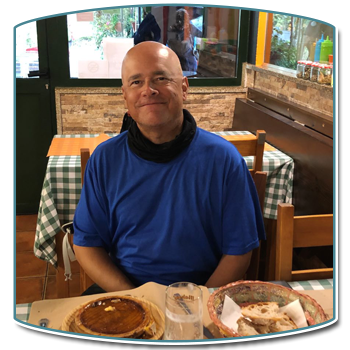
Our thanks to Scott for sharing his adventure. You can read more about his trek in a series of articles he contributed from the trail to the Culpeper Times in September and October 2019; these are posted online at insidenova.com.
Member spotlight: Meet Dan and Karen
We’re fortunate to live in Virginia where the climate typically allows for year-round enjoyment of hiking, with seasonal changes offering a different perspective on local trails. PWC member Dan volunteers as a trail overseer for the Potomac Appalachian Trail Club (PATC). Dan and his wife Karen have been members of PWC for about a year and a half and their routine at PWC supports strength and endurance for their trail outings.

Dan is responsible for the trail section in Shenandoah National park heading south from Mary’s Rock to Birds’ Nest #3 (Mary’s Rock is near the Overlook visitors’ area on Skyline Drive south of the Thornton Gap intersection with Route 522). This section comprises 1.3 miles – which he accesses via a one-mile hike from the Meadow Spring trail head and parking area. Karen accompanies Dan on some of the trail maintenance outings and also plays a key role as Dan’s “support team.” While she enjoys hiking, she prefers the day hikes over the longer backpacking outings. They enjoy hiking the trails off of Big Meadows together.
The PATC describes trail overseers as “the foundation of the PATC trail system” and the club’s expectation is that overseers will visit their assigned section at least 4 times during the year. Throughout the year, even in the winter, Dan will hike up to see what’s been happening on the trail. He will address any issues he finds, such as clearing waterbars for better trail drainage, or perhaps send a call out to the club if volunteers are required for a larger problem like a big blowdown. (Within PATC, different groups focus on different aspects of support.)
Summer hikers may spot Dan working on weed whacking along the trail to keep it passable. Dan says he appreciates the thanks hikers direct his way – their gratitude is typically expressed in tandem with surprise that the trails are maintained so attentively. His duties have expanded as he has recently become the district manager for the central section of the Appalachian Trail in Shenandoah National Park.
How did Dan’s interest in trail maintenance develop? As a longtime recreational hiker, he became more and more interested in the important work of maintaining trails to support usage and reduce environmental impact. The tipping point was meeting a 70-year-old thru-hiker on the trail; Dan was inspired to get involved and also to get in better shape. After working out on his own, he realized he wasn’t training properly to support the physical stamina of his trail role. While his personal gear may be light, factoring in heavy or awkwardly sized equipment and ups-and-downs of mountain trails is very strenuous work.
As a Christmas present, Karen gifted Dan with personal trainer sessions. Beginning early in 2019, Dan worked with personal trainer Heather Boggess to develop a regimen of exercises and training with resistance bands. He notes that his program with Heather was very helpful, because it focused on supporting his unique needs. He lost excess weight and developed more strength, including core strength, which he describes as “very important to being able to enjoy what you are doing out there.”
Heather also tailored an exercise plan for Dan to follow while working his job as a tugboat engineer. Within the constraints of a limited space, he’s able to maintain his fitness routine in the tugboat’s gym that has strength and cardio equipment.
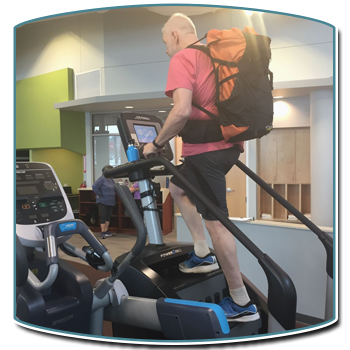
Dan’s routine at PWC continues to focus on strength, cardio/aerobic fitness and endurance. You may have seen him training on one of the cardio machines while wearing his weighted backpack: 25-28 pounds for training and 10 pounds for maintenance. He does a strength circuit and the Jacob’s Ladder (without the pack) and the elliptical, step or treadmill (with the pack). Karen’s fitness choices include the rowing machine and pool walking to maintain cardiovascular fitness and strength. Their current focus includes core strength and staying active with cardio workouts, and they challenge each other on the Jacob’s Ladder.
Thanks to Dan and Karen for sharing their story of how their fitness efforts at PWC support their outdoor recreation.
Happy trails to everyone heading out this fall to enjoy Virginia’s many hiking opportunities!
The Potomac Appalachian Trail Club, founded in 1927, maintains and protects the Appalachian Trail and nearby land in the mid-Atlantic region through volunteer efforts, education and advocacy. PATC offers group hikes, and classes and workshops related to outdoor skills and interests. If you would like to learn more about the PATC, please visit www.patc.net
Member spotlight: Meet Diane
Diane is a survivor in the fullest definition of the word. She saw her mom and her sister pass from cancer, and then received her own cancer diagnosis, despite having tested negative for the indicator for the disease. She is now celebrating more than two years post-diagnosis. For Diane, PWC has served as both a retreat space and a recovery center.

Diane with trainer Sarah Mahoney
Diane first came to PWC through the FitScripts program, which she says gave her a great introduction to the center. When her sister was diagnosed with invasive ductal carcinoma, Diane stepped up to serve as her caregiver. She returned to PWC during this very stressful and sad period, and found solace in walking in the pool current. “My mental therapy was walking in the pool,” she remembers.
Realizing that she needed to be proactive about her health, Diane underwent the BRCA test that indicates disease susceptibility in breast cancer indicator genes. She tested negative, but was considered high risk, which meant that her screening measures were intensified. In early fall 2016 after a screening, she got the call confirming cancer had been found.
After recovering well from surgery, Diane was laid low by a lingering cold that severely affected her strength and endurance for daily activities. For about 6 months, she was unable to get back to her job as a merchandiser that requires lots of lifting and driving. For support, her employer had matched her up with another employee who had gone through breast cancer. “She was great to talk to and we spoke regularly. At the time she was a 5-year survivor and she offered me such support, strength and optimism,” notes Diane.
She adds, “My husband Edwin was my rock. He kept track of all the medical information and was a really good caregiver for me. My kids were awesome, too. They had seen their aunt struggle but were so great about caring for her with activities she enjoyed, like doing her nails.”

Diane and her family
In addition to the support she received from her family and work colleague, Diane participated in the cancer support group at Fauquier Hospital. She also continues to be a member of invitation-only Facebook groups for cancer patients and survivors – “my sisters,” she says. She does advise anyone looking into online groups to be careful of personal privacy and wary of scams.
Another effort that Diane appreciates is Culpeper County’s Relay for Life at Eastern View High School. She is on the hospital’s team for this annual walk and says that it has been fantastic for her recovery.
After reconstructive surgery, Diane decided to take action to combat weight she had gained during her post-surgery recovery period and from medication side effects. She was plagued by frequent colds and back pain and wanted to improve her health and regain muscle.
In her initial efforts, Diane was supported by the Culpeper Medical Center physical therapy staff. “At first, I could barely walk around the track,” Diane notes. After she regained some strength, her doctor suggested Weight Watchers (now known as WW). She also started working with a trainer at PWC.
Diane has lost 50 pounds, and has gone from a size 16 to a size 4. “I’ve reached my goal,” she says. “I’m now working to maintain my weight with WW. It does take discipline and it’s up to you how you want to manage it. My scale, FitBit and WW app are all synced to help me keep track.”
Her current regimen at PWC includes sessions twice a week with PWC trainer Sarah Mahoney, focusing on developing full body strength through the core, arms and legs. Diane shares the happy news: “My back pain is gone, I hardly get colds, and I’m stronger. I’m back to work, and reaching 10,000 daily steps is easy with my job!”
Thanks to Diane for sharing her story and best wishes to her as she continues on her health journey.
Member spotlight: Meet Paul
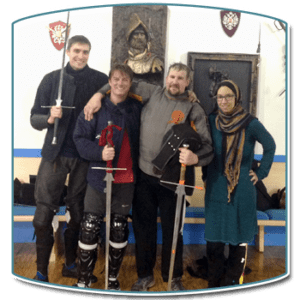
PWC member Paul, center left, with sparring partner Josh, and Virginia Academy of Fencing members Joe and Iman
Imagine wielding a 3-pound sword while wearing a heavy helmet, thick padded clothing, and protective coverings for your arms and legs — moving about in this gear presents challenge enough. Add the intense physical demands of swordplay with an opponent ― endurance, strength, agility and flexibility are needed for success in a match. There’s no doubt about it, PWC member Paul’s recreational passion, historic European martial arts (HEMA), requires a high level of fitness.
With an interest in swordplay, Paul spent about two years looking into recreation opportunities before HEMA came to his attention. Paul liked HEMA’s emphasis on historical accuracy; to develop and fine tune their skills, many instructors and participants work with copies of ancient manuscripts that were created as instructional manuals by masters of the art of sword play from the 14th through the 16th century.
Paul’s particular interest in the world of historic European martial arts is the German longsword. This sword is wielded two-handed; Paul pointed to the movie Braveheart as an example of this type of swordsmanship. (Other historic martial arts involve the Italian rapier – remember the movie The Princess Bride? – and the Scottish broadsword – think Pirates of the Caribbean.)
When Paul sought out a trainer to work with at Powell Wellness Center, his goal was to achieve a level of fitness that would support him and help him excel at his chosen recreational activity. Over the course of a year, he worked with his trainer on body mechanics and correct form with weight lifting for strength development, as well as endurance through high intensity training. Sessions on the rowing machine for a cool-down period completed his training regimen. “My routine was not about powering through. It was about doing it correctly and developing strength with good form. I built a bigger gas tank for swordfighting, and I have never had such great confidence in myself until I worked with a trainer,” notes Paul.
He drives weekly to northern Virginia for his classes at the Virginia Academy of Fencing (VAF), which offers Olympic sport fencing in addition to historical swordsmanship. After his session, Paul partners with his “battle buddy” Josh Yeager, a seasoned swordsman, for one-on-one training. Paul feels he needs two years under his belt before entering competition, although he has participated in mock tournaments that teach participants what to expect during a formal tournament.
Asked what he would say to anyone interested in HEMA, Paul advises, “When you begin, don’t be scared. There is a level for everyone. Maybe you’re into Star Wars and want to look good with your light saber. At the Virginia Academy of Fencing they will match the level and intensity that you want to bring.” He described how the VAF supports many different ages and abilities, highlighting as an example a mother and son duo who regularly visit the academy for instruction.
Paul added, “The people I have met through this sport are incredibly kind and nice. There is respect and honor toward fellow participants and a lot of supporting one another through sharing tips. I’ve developed confidence through the swordplay and medieval wrestling. The physical gains I’ve made are going to help me when I enter competition.”
Recently Paul has taken Powell classes like BodyPump™ and TRX™ with his fiancée. He’s hoping to also do a yoga class. Sounds like he’s building on the gains he’s experienced from personal training with some serious cross training.
If you are interested in HEMA, take a look at the Historic European Martial Arts Alliance (hemaalliance.com). HEMA’s online presence includes videos on YouTube that show competitions.
Member spotlight: Meet Miss Shirley
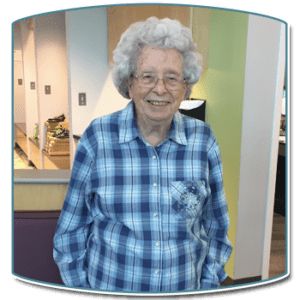
It’s a pleasure to shine the spotlight on PWC member Miss Shirley, a “regular” in the aquatic facility with a biweekly routine. Miss Shirley travels to Powell from her home in Madison County where she has lived for 60 years. She became a member of Powell in 2007, the center’s inaugural year.
Over the years Miss Shirley has been a member, she has adjusted her fitness activities to serve her changing needs. Early in her membership she participated in the aquatic fitness classes, and she still remembers one of Sharon Steele’s morning classes fondly. After experiencing two knee replacements, she shifted from group aquatic fitness classes to enjoying the pool on her own.
Miss Shirley’s aquatic routine offers therapeutic, cardiovascular and strengthening benefits. During her hour-long visits, she enjoys standing in the walking oval where the water for the current emerges. It’s a great spot to relax with the swirl of the warm water, which is soothing for joint or muscle discomfort. After about 5 minutes of savoring the warm current, she’ll next take a lap around the walking oval, then do another current soak. All told, her routine takes about an hour and makes great use of the pool’s therapeutic and fitness aspects.
Our thanks to Miss Shirley for sharing her wellness story.
Member spotlight: Meet Maxine
Are you familiar with the Senior Games? Every state offers this opportunity for individuals 50 and older to compete in a variety of sports that can range from archery to track and field. At their state’s games, athletes may qualify for national competition. State competitions alternate on a yearly rotation with the National Senior Games competition. Virginia has a long history of participation: 2018 marks the 40th anniversary of the Virginia Senior Games.
 Powell Wellness Center member Maxine is a former Senior Games athlete, as is her husband Bernard. In fact, over the course of their 10 years of participation in the state games in Virginia and West Virginia, Maxine and Bernard between them won 75 medals in gold, silver and bronze!
Powell Wellness Center member Maxine is a former Senior Games athlete, as is her husband Bernard. In fact, over the course of their 10 years of participation in the state games in Virginia and West Virginia, Maxine and Bernard between them won 75 medals in gold, silver and bronze!
Maxine says she has always been very active, and the Senior Games seemed like a fun thing to do. She played basketball in high school, so that sport was a natural choice for her when she became involved in the Games. She won the gold medal for basketball free throws when she was 66 years old. That achievement occurred one year after she had completed five years of treatment for breast cancer. She also participated in team basketball. At one point, Maxine’s team was all set to compete in the National Senior Games. Unfortunately, one of her teammates was diagnosed with an illness and they were unable to compete.
Maxine also participated in 50 and 200 meter races and played horseshoes. Bernard’s sports were golf, basketball, and volleyball.
Senior Games-related travels took her to Utah, Louisiana, Pennsylvania, and also within Virginia when the Senior Games were hosted in Newport News.
Although she no longer competes in the games, Maxine remains active. At PWC, she typically walks 3-4 miles on the track three times a week. If for some reason she can’t finish her mileage at PWC, she walks on her driveway. She also works out with the strength building machines at PWC.
Maxine recalls that she was interviewed by her great nephew as part of a project he was working on for Breast Cancer Awareness Month. Her message to other women was upbeat: “Do not get discouraged, you can overcome the challenge.”
Her recollections of Senior Games activities are similarly upbeat: she is proud of her effort and grateful that she had the good health and strength to participate. And the 75 medals earned by her and her husband? Many were used as prizes at fun events that they have hosted over the years! We’re glad she was able to display one of her medals for the Member Spotlight photo!

